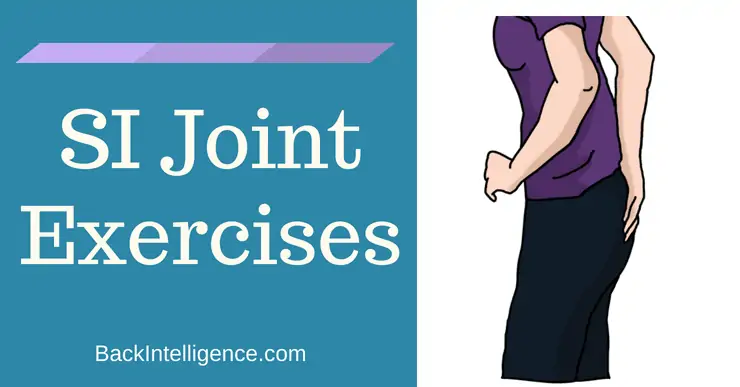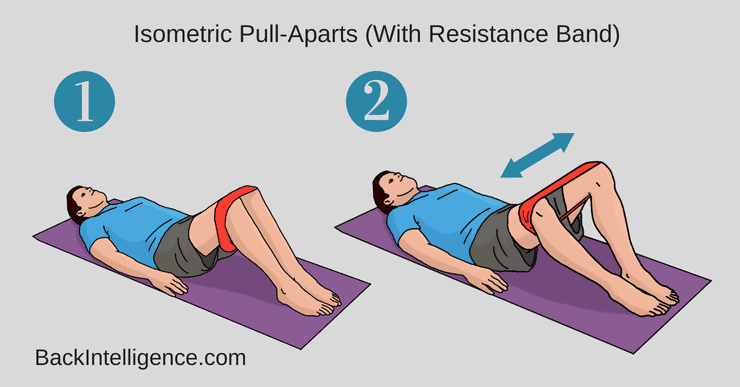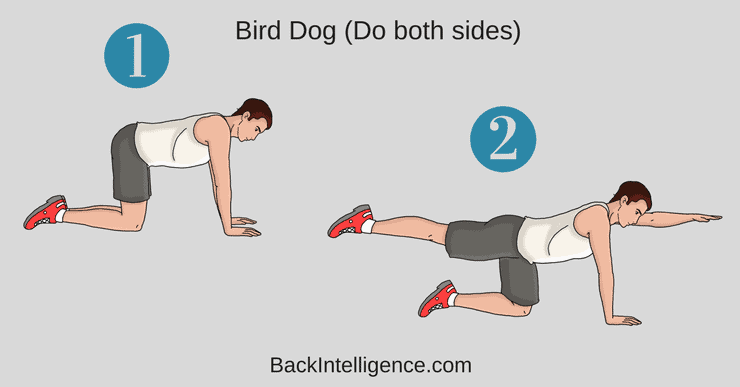
If you’ve ever suffered with Sacroiliac (SI) Joint pain, you know just how debilitating it can be – it can make simple, every day tasks such as rolling over in bed, or getting in and out of your car difficult, and can seriously affect your quality of life.
Luckily, with the right sacroiliac joint exercises (below) you can get relief.
Let’s take a closer look at what SIJ pain is, what causes it, and what you can do to manage your symptoms.
What is Sacroiliac Joint Pain?
The sacroiliac joint (SIJ) is a major contributor to low back pain, affecting on average, approximately 15% to 25% of low back pain sufferers.[1][2]
The SI Joint is the joint that connects the sacrum, which is the triangular shaped bone located at the bottom of your spine (just above your tailbone), to the left and right sides of your iliac bones, which are the large bones that form your pelvis.[2][3]
The sacroiliac joints are incredibly important as they support the weight of your torso when you’re upright; help maintain balance as you walk, and act as shock absorbers for your spine.[3][6][7]
Symptoms of SI Joint pain include:
- Dull, achy lower back pain on one side, below the L5 level (although it may be felt on both sides in some cases).[3]
- Pain that radiates to the hips, groin, and/or buttocks.[3]
- Numbness and tingling that may radiate into the buttocks and/or back of the thigh (this type of pain can also extend below the level of the knee.).[2][3]
- Spasms and decreased range of motion in the muscles of the lower back, pelvis, hips, and groin that may result in difficulty with walking, bending, and/or changing positions from sitting to standing.[2][3]
- Increased pain when pressure is applied to the affected SIJ – For example, standing on one leg.[2][3]
- Instability of the lower back and/or pelvis, which may lead to a feeling that the pelvis is going to “give out” when walking, or standing.
- Sleep disturbances due to pain.
- Inability to sit for prolonged periods due to pain.
The Main Causes of SI Joint Pain
SIJ pain is usually attributed to sacroiliac joint movement dysfunction:
Hypermobility (instability)
This means that there is too much movement of the SIJ that can cause the pelvis to feel unstable and ultimately lead to pain.[2][7]
Hypomobility (fixation)
This means that there is too little movement of the SIJ that leads to tense muscles, pain, and decreased range of motion.[2][7]
What can cause the movement dysfunctions in this joint:
– Gait (how you walk) and postural abnormalities including scoliosis and leg length discrepancies place unequal pressure on one side of the pelvis, resulting in wear and tear of the SIJ.[2][7]
– Postural misalignments.[7]
– Continuous trauma or stress to the SIJ such as repeated heavy lifting, and contact sports can lead to SIJ pain, especially if the muscles of the lower back and pelvis are not conditioned properly.[2][7]
– Increasing age resulting in wear and tear of the SI joints.[7]
– Pregnancy and post-partum are common causes of SIJ pain because of an increase in weight, stretching of the abdominal muscles to accommodate an expanding uterus, shifting hormone levels, which cause the SIJ to become hypermobile, as well as the pelvic changes that occur during childbirth. While these changes resolve for most women, if the ligaments remain loose following childbirth, on-going SIJ pain and instability can result.[2][7]
– Previous lower back surgery and hip joint replacement may displace pressure onto the SIJ, especially after spinal fusion surgery, and multilevel surgeries.[2][8]
– Prolonged sitting or standing – esp in poor posture.[2][7]
– Obesity can put more pressure on the Si Joint leading to pain.[2]
– In addition, in some cases, SIJ pain may be the result of inflammation, known as sacroiliitis. It is a painful condition where either one or both of the sacroiliac joints become inflamed.[2][3]
Home Treatments for SIJ Pain:
Ice + Exercises
Start by applying ice for 15 minutes at a time (For several days) to the affected SIJ to help reduce inflammation, which in turn will help to alleviate pain and discomfort.
After you have reduced some of the inflammation proceed to the exercises below.
The Complete Low Back Fix (With Dr. Oliver, DC)
Ease your Low back pain, gain mobility and get back to the things you enjoy doing.
Learn More
6 Effective SI Joint Exercises
The primary purpose of the sacroiliac joints is to maintain stability therefore, for the purpose of this article, we’ll focus on stabilizing/strengthening exercises for the muscles around the Si Joint. The muscles we will target include:
– Gluteus Maximus,
– Gluteus Medius
– Piriformis
– Pelvic floor muscles
– Core muscles (Transverse Abdominis, Obliques, and more)
Exercise #1: Isometric Knee Push
How it helps:
Strengthens the muscles of your buttocks, thereby helping to improve stability of the SIJ.
How to do it:
– Begin by lying on your back.
– Bring your left knee up towards your chest, while keeping your right leg straight
– Position your hands, interlocked, underneath the kneecap
– Push your left knee into your hands (away from the chest)
– Be sure to resist the knee pushing out with your hands
– Hold for 5 seconds
– Aim for 10 repetitions
Exercise #2: Bridge
This exercise helps to strengthen both your core, gluteal and back muscles.
How to do it:
Begin lying on your back on the floor with your knees bent and feet positioned flat on the floor with your arms positioned beside your torso.
– Brace your core and squeeze your butt before any movement.
– While bracing, lift your butt off the floor, and continue squeezing your butt.
– Hold this position for 5 seconds and return slowly to the starting position.
– Aim for 10 repetitions.
**Don’t hyperextend during this movement, you should feel your glutes firing.
Exercise #3: Ball Squeeze
How it helps:
Improves core and buttocks muscle stability, thereby improving stability of the SIJ.
How to do it:
– Begin lying on your back, with your knees bent to 90 degrees, with a ball positioned in between your knees, and feet positioned flat on the floor.
– Have a natural arch to your low back and pull your bellybutton in towards your spine.
– Squeeze the ball with your knees.
– Hold for 10 seconds.
– Aim for 10 repetitions.
Exercise #4: Core isometric with Resistance bands
How it helps:
You’re challenging your pelvis and lower back muscles with this exercise to increase stability of the SI Joint.
How to do it:
– Begin lying on your back, with your knees bent to 90 degrees, and the band wrapped around your knees.
– Slightly pull your knees apart and bring them back together.
– Aim for 15 to 20 repetitions.
Exercise #5: Gluteus Medius Strengthening
How it helps:
The gluteus medius muscle is one of the main stabilizers of the pelvis, so this exercise will strengthen it.
How to do it:
– Lie on on side on the floor with the feet and legs stacked on top of each other.
– Lift on leg slowly and hold for 2 seconds in the air.
– Bring the leg down slowly.
– Repeat on the other side.
* You don’t need to lift the leg too high to feel it working.
Exercise #6: Bird Dog
This is a great exercise to improve core strength and lumbar back muscles.
How to do it:
– Begin on your hands and knees, with your hands positioned under your shoulders and knees positioned under your hips.
– Brace (contract) your core as hard as you can before beginning any movement.
– While bracing your core, raise your left arm and reach it forwards until it is aligned with your torso; at the same time, kick your right leg backwards until is it aligned with your torso.
– It’s important to not arch your low back as you do this.
– Hold this position for 2-3 seconds before slowly returning to the starting position.
– Repeat with your right arm and left leg.
– Alternate sides for 10 repetitions.
** Only extend your arm and leg to where it’s comfortable and don’t arch your low back.
Watch our SI Joint Exercises Video
Conclusion,
If you’re suffering with SIJ pain that is interfering with your life, home treatment including ice, as well as SIJ stabilization exercises can help set you on the right path towards pain free movements. However, in some cases, your pain may not resolve, and you may need to seek out a healthcare provider, such as a physical therapist or chiropractor, to help get your symptoms under control.
Learn More
Related:
How to do the bridge exercise
Are Sit ups bad for your back?
Sciatica facts and exercises
How to sleep with lower back pain
Sources:
[1] Laslett M. Evidence-based diagnosis and treatment of the painful sacroiliac joint. Journal of Manual & Manipulative Therapy. 2008;16(3):142-152. doi:10.1179/jmt.2008.16.3.142
[2] Cohen S. Sacroiliac joint pain: A comprehensive review of anatomy, diagnosis, and treatment. Anesthesia & Analgesia. 2005;101(5):1440-1453. doi:10.1213/01.ane.0000180831.60169.ea
[3] Hamidi-Ravari B, Tafazoli S, Chen H, Perret D. Diagnosis and current treatments for sacroiliac joint dysfunction: A Review. Curr Phys Med Rehabil Rep. 2014;2(1):48-54. doi:10.1007/s40141-013-0037-7
Licensed chiropractor, DC (Owner of Forme Clinic, Stoney Creek, ON, L8G 1B9)
Dr. Shaina McQuilkie graduated from Brock University in 2004 with a Bachelor of Kinesiology (Honours). She then attended D’Youville College, in Buffalo, New York and obtained her Doctorate of Chiropractic Degree in 2008. After graduating, Dr. McQuilkie practiced in a multi-disciplinary healthcare facility based in Hamilton, Ontario gaining experience treating a variety of musculoskeletal injuries.








